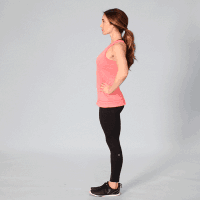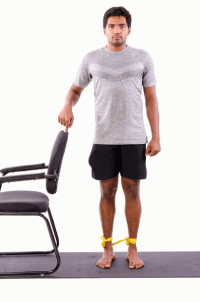Every step you take, every move you make, your hip flexors are hard at work, ensuring seamless movement. But what happens when this crucial component of your mobility starts to falter? Imagine the discomfort of a rubber band fraying with overuse — that’s how hip flexor tendinopathy can feel. For athletes and active individuals, this condition isn’t just an inconvenience; it’s a roadblock. Delve into the intricacies of hip flexor tendinopathy with us, from its telltale symptoms to the most effective recovery strategies.
Contents
Understanding Hip Flexor Tendinopathy
The human body is a marvel of engineering, with each part playing a unique role in our daily activities. Among these, the hip flexors are pivotal players, ensuring we can walk, run, and even dance with grace. But like all intricate machinery, sometimes, things go awry. Enter: Hip Flexor Tendinopathy.
Hip flexor tendinopathy refers to the inflammation or degeneration of the tendons that connect the hip flexor muscles to the bone. In layman’s terms, it’s akin to the wear and tear of a well-used rope, leading to pain, stiffness, and reduced mobility. The condition is often a result of chronic overuse, particularly in activities that require repeated hip flexion, such as sprinting, kicking, or climbing.
For active individuals, understanding this condition is paramount. It’s not merely about addressing pain but ensuring the longevity of one’s athletic pursuits. A compromised hip flexor can drastically impact performance, transforming simple activities into strenuous tasks. Additionally, undiagnosed or untreated tendinopathy can lead to more severe complications, affecting overall physical health and well-being.
Common Causes Behind the Condition

The path to hip flexor tendinopathy is often paved with a mix of physical demands and certain underlying predispositions. While each individual’s journey may be unique, understanding the common causes can offer crucial insights into prevention and management. Here’s a deep dive into the frequent culprits:
- Overuse and Repetition: At the forefront of causes is the repetitive strain. Activities that entail continuous hip flexion, such as long-distance running, cycling, or certain martial arts, can place immense strain on the hip flexor tendons. Over time, without adequate rest and recovery, this can lead to inflammation and degeneration.
- Improper Training Techniques: Jumping into intense workouts without a proper warm-up, or neglecting the importance of correct form, can be detrimental. Mistakes in technique can place undue stress on the hip flexors, expediting the onset of tendinopathy.
- Muscle Imbalances: When certain muscle groups are stronger than others, it can result in uneven force distribution during physical activities. For instance, strong quadriceps paired with weak hamstrings can put excessive pressure on the hip flexors.
- Underlying Health Conditions: Certain systemic conditions, such as rheumatoid arthritis or lupus, can make one more susceptible to tendinopathies, including that of the hip flexors.
- Inadequate Footwear: It might seem distant, but your feet play a role too! Improper footwear, especially during high-impact activities, can affect gait and hip alignment, indirectly contributing to hip flexor strain.
Recognizing these potential causes is the first step toward proactive care. Whether it’s adjusting training techniques, addressing muscle imbalances, or simply being mindful of one’s limits, understanding the origins of hip flexor tendinopathy can pave the way for healthier, pain-free movement.
Can Hip Flexor Tendonitis Be Cured or Treated?
The journey from hip flexor tendinopathy (often referred to as tendonitis when inflammation is involved) to recovery is both a question of medical intervention and self-care. The good news is that with the right approach, many individuals can find relief and even a complete resolution of their symptoms. Let’s delve into the practical steps one can take to facilitate the healing process:
- Rest is Crucial: Give the inflamed or degenerated tendons a break. This doesn’t mean complete immobility but rather a reduction in activities that exacerbate pain.
- Gentle Stretching: Incorporate gentle hip flexor stretches to maintain flexibility. An example is the standing hip flexor stretch, where one pulls the heel towards the buttock while keeping the knees together.
- Strength Training: Once the acute phase has passed, strengthening exercises can fortify the muscles surrounding the hip, offering better support.
- Anti-Inflammatory Diet: Incorporate foods rich in omega-3 fatty acids like fish, walnuts, and flaxseeds.
- Manage Weight: Carrying extra weight can put added strain on the hips. A balanced diet and regular exercise (within comfort limits) can help manage body weight, reducing the load on your tendons.
- Physical Therapy: Consulting a physical therapist can provide tailored exercises and stretches to promote healing and prevent recurrence. They can also offer modalities like ultrasound or laser therapy to address pain and inflammation.
- NSAIDs & Medications: Over-the-counter pain relievers like ibuprofen can reduce pain and inflammation. However, they should be used under guidance and not as a long-term solution.
- Ice and Heat Therapy: During the initial phases, icing can help manage inflammation. As healing progresses, alternating between cold and heat can help soothe the area and improve blood circulation.
- Massage and Soft Tissue Work: Gentle massages can aid in breaking down scar tissue and promoting blood flow. It’s essential to consult a professional familiar with hip flexor injuries.
In essence, while hip flexor tendonitis might present challenges, with a comprehensive approach encompassing medical advice and self-care, recovery is well within reach.
Exercises to Strengthen and Protect
By prioritizing strength and flexibility in the hip region, not only can we expedite the recovery process, but we also fortify the area against future incidents. Here’s a curated list of exercises designed to bolster the hip flexors and their neighboring muscles:
Bridges

- How to: Lie on your back with knees bent and feet flat on the floor. Press through your heels to lift your hips off the ground, squeezing the glutes at the top. Lower down slowly. This engages the glutes, hamstrings, and core, providing better support to the hip flexors.
Standing Hip Flexion

- How to: Stand tall with feet hip-width apart. Holding onto a support, raise one knee towards your chest without leaning backward. Lower it back down gently.
Leg Raises

- How to: Lie on your back with legs extended. Keeping one leg on the ground, lift the other leg to about 45 degrees, then lower it without letting it touch the floor. Alternate legs.
Resistance Band Hip Flexion

- How to: Anchor a resistance band under one foot. Loop it around your ankle and lie on your back. Lift your knee towards your chest against the band’s resistance, then slowly return.
Hip Abduction with Band

- How to: Stand with a resistance band looped around both ankles. Keeping your knees straight, move one leg out to the side against the band’s pull, then return to the starting position.
Hip Adduction with Band

- How to: Anchor a band and loop it around one ankle, standing sideways to the anchor. Pull the looped leg inward, crossing the other leg, then return.
Clamshells

- How to: Lie on your side with knees bent at 90 degrees and feet together. Keeping feet touching, lift the top knee as high as possible without moving the pelvis, then close it.
Incorporating these exercises into your routine can provide a solid foundation for hip health. However, it’s essential to approach them with mindfulness, ensuring proper form and avoiding overexertion.
Conclusion
Hip flexor tendinopathy can be a daunting condition to navigate, but with the right knowledge, tools, and guidance, recovery is not just a possibility—it’s a probability. The strength and resilience of our body are profound, and with dedicated care and attention, it can bounce back from challenges with renewed vigor. If you’re experiencing Hip pain, physical therapy for hip pain at PhysioMantra can help: Book an online physical therapy session.



